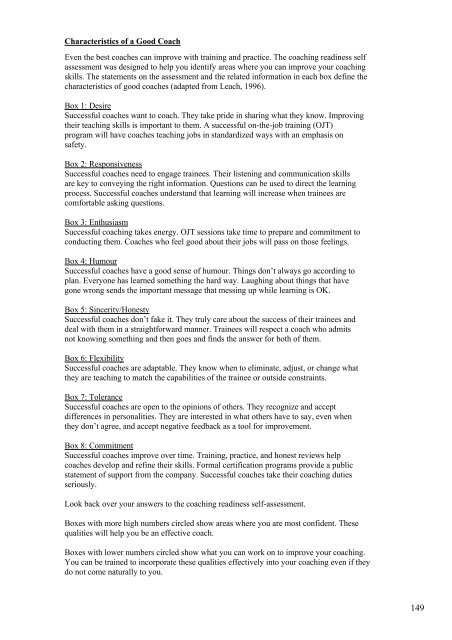How to Perform On-the-job Training - Dean Amory
According to The Encyclopedia of Business, ©2000 Gale Cengage, On-the-job training is by far the predominant form of job training. Studies also indicate that it is the most effective form of job training. Yet, it also represents a significant investment considering that roughly 30% of a new worker's time is spent in on-the-job training during the first 90 days of employment, that productivity of experienced workers assigned to train new workers may decrease during the training period, and that new workers may make expensive mistakes. Both companies and workers therefore profit largely from the presence of simple, but complete trainee and trainer guides that allow for executing OJT in a structured way. “How to perform on-the-job training”, has the information, techniques and tips that will allow you to implement a professional OJT training program. The book also includes all the tools, documents and checklists necessary for setting up a qualitative and efficient skills training program for OJT coaches
According to The Encyclopedia of Business, ©2000 Gale Cengage, On-the-job training is by far the predominant form of job training. Studies also indicate that it is the most effective form of job training. Yet, it also represents a significant investment considering that roughly 30% of a new worker's time is spent in on-the-job training during the first 90 days of employment, that productivity of experienced workers assigned to train new workers may decrease during the training period, and that new workers may make expensive mistakes.
Both companies and workers therefore profit largely from the presence of simple, but complete trainee and trainer guides that allow for executing OJT in a structured way.
“How to perform on-the-job training”, has the information, techniques and tips that will allow you to implement a professional OJT training program. The book also includes all the tools, documents and checklists necessary for setting up a qualitative and efficient skills training program for OJT coaches
Create successful ePaper yourself
Turn your PDF publications into a flip-book with our unique Google optimized e-Paper software.
Characteristics of a Good Coach<br />
Even <strong>the</strong> best coaches can improve with training and practice. The coaching readiness self<br />
assessment was designed <strong>to</strong> help you identify areas where you can improve your coaching<br />
skills. The statements on <strong>the</strong> assessment and <strong>the</strong> related information in each box define <strong>the</strong><br />
characteristics of good coaches (adapted from Leach, 1996).<br />
Box 1: Desire<br />
Successful coaches want <strong>to</strong> coach. They take pride in sharing what <strong>the</strong>y know. Improving<br />
<strong>the</strong>ir teaching skills is important <strong>to</strong> <strong>the</strong>m. A successful on-<strong>the</strong>-<strong>job</strong> training (OJT)<br />
program will have coaches teaching <strong>job</strong>s in standardized ways with an emphasis on<br />
safety.<br />
Box 2: Responsiveness<br />
Successful coaches need <strong>to</strong> engage trainees. Their listening and communication skills<br />
are key <strong>to</strong> conveying <strong>the</strong> right information. Questions can be used <strong>to</strong> direct <strong>the</strong> learning<br />
process. Successful coaches understand that learning will increase when trainees are<br />
comfortable asking questions.<br />
Box 3: Enthusiasm<br />
Successful coaching takes energy. OJT sessions take time <strong>to</strong> prepare and commitment <strong>to</strong><br />
conducting <strong>the</strong>m. Coaches who feel good about <strong>the</strong>ir <strong>job</strong>s will pass on those feelings.<br />
Box 4: Humour<br />
Successful coaches have a good sense of humour. Things don’t always go according <strong>to</strong><br />
plan. Everyone has learned something <strong>the</strong> hard way. Laughing about things that have<br />
gone wrong sends <strong>the</strong> important message that messing up while learning is OK.<br />
Box 5: Sincerity/Honesty<br />
Successful coaches don’t fake it. They truly care about <strong>the</strong> success of <strong>the</strong>ir trainees and<br />
deal with <strong>the</strong>m in a straightforward manner. Trainees will respect a coach who admits<br />
not knowing something and <strong>the</strong>n goes and finds <strong>the</strong> answer for both of <strong>the</strong>m.<br />
Box 6: Flexibility<br />
Successful coaches are adaptable. They know when <strong>to</strong> eliminate, adjust, or change what<br />
<strong>the</strong>y are teaching <strong>to</strong> match <strong>the</strong> capabilities of <strong>the</strong> trainee or outside constraints.<br />
Box 7: Tolerance<br />
Successful coaches are open <strong>to</strong> <strong>the</strong> opinions of o<strong>the</strong>rs. They recognize and accept<br />
differences in personalities. They are interested in what o<strong>the</strong>rs have <strong>to</strong> say, even when<br />
<strong>the</strong>y don’t agree, and accept negative feedback as a <strong>to</strong>ol for improvement.<br />
Box 8: Commitment<br />
Successful coaches improve over time. <strong>Training</strong>, practice, and honest reviews help<br />
coaches develop and refine <strong>the</strong>ir skills. Formal certification programs provide a public<br />
statement of support from <strong>the</strong> company. Successful coaches take <strong>the</strong>ir coaching duties<br />
seriously.<br />
Look back over your answers <strong>to</strong> <strong>the</strong> coaching readiness self-assessment.<br />
Boxes with more high numbers circled show areas where you are most confident. These<br />
qualities will help you be an effective coach.<br />
Boxes with lower numbers circled show what you can work on <strong>to</strong> improve your coaching.<br />
You can be trained <strong>to</strong> incorporate <strong>the</strong>se qualities effectively in<strong>to</strong> your coaching even if <strong>the</strong>y<br />
do not come naturally <strong>to</strong> you.<br />
149


















